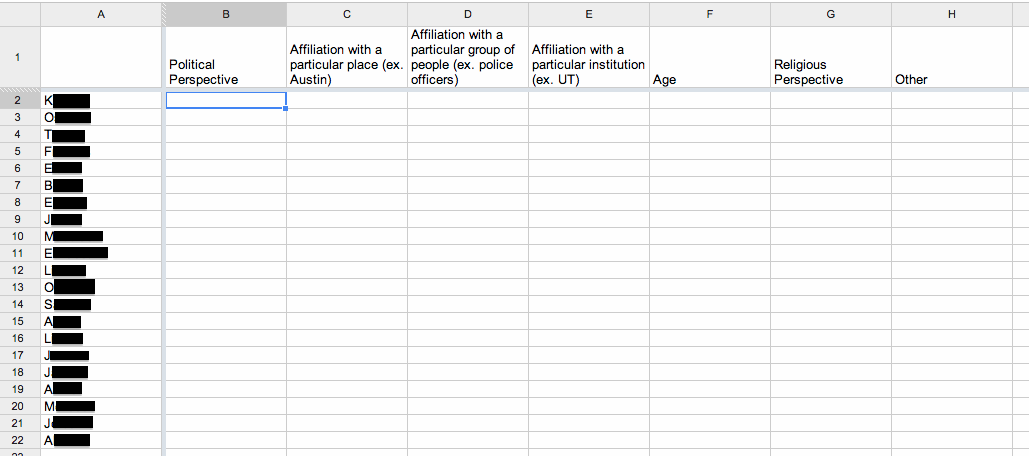You are here
Using Google Drive for Collaborative Bias Analysis
Primary tabs

In this exercise, students research potential sources of bias within a set of assigned texts and add their notes to a Google Drive spreadsheet. The students and instructor then review the spreadsheet as a group and finish with a class discussion.
Bias Analysis
Google Drive
Google Spreadsheets
Required:
-individual computers for each student or pair of students
-access to Google Drive for all students
-pre-assigned readings
Recommended:
-overhead projector
More information:
Prior to class, the instructor should assign short online readings and create a corresponding Google Drive spreadsheet (see more under "Full Assignment Description"). I would strongly recommend a set of three readings about the same general topic but from different perspectives.
In class, each student (or pair of students, if the instructor prefers) will need a computer and access to the Google Drive spreadsheet. Ideally, the instructor should also be able to show the spreadsheet using an overhead projector.
BEFORE CLASS:
Prior to class, I assigned a set of short online readings. During a seventy-five minute class period, we were able to address three short readings, but instructors with shorter classes might want to work with only two. As indicated above, I recommend choosing articles about the same topic (for coherence) but written from different perspectives (for contrasting in class discussion). For example, I assigned three articles about ecotourism. The first was published on an elite US-based travel magazine website, the second came from a popular Caribbean news source, and the third was part of a specific travel agency's commercial site.
With these texts in mind, I created a Google Drive spreadsheet with three tabs, one for each article. Each was formatted the same way. For the left-hand column, I wrote each student's name, such that each student had one assigned row for each tab. On the top row, I listed different categories to consider while analyzing bias (these can vary, but I included criteria like political perspective, institutional affiliations, geographical affiliations, age, and religious perspective). I recommend freezing both the column with the students' names and the row listing the criteria, so that the students can navigate more easily. Freezing rows and/or columns will appear as an option under the "View" tab above the spreadsheet.
Shortly before class, I invited all of my students to access the Google Drive. Sending the invitation in advance saved some class time.
DURING CLASS:
At the beginning of class, we had a brief conversation about bias. We discussed the relationship between bias and credibility, what factors might impact an author's bias, etc. I made sure to introduce the criteria I had included on the spreadsheet. I also gave a quick introduction to Google Drive spreadsheets, since most of my students weren't familiar with them.
The students were then asked to review the readings, research the authors and venues of the readings, and fill out their own rows for each of the spreadsheet's three tabs. If they could not find a piece of information or did not believe it was applicable, I asked them to mark the box with "N/A" to indicate that they had at least considered the question. As they worked, I showed one of the tabs using the overhead projector. I also circulated around the room to answer questions. While I chose to have the students create their notes individually, an instructor could also have them work in pairs, if desired or needed.
After they had filled in their boxes, we looked together at each spreadsheet tab. I chose to do this part using the overhead projector, but if that option isn't available, students could also just look at their own screens. Instructors could choose from a number of discussion questions at this point. In our case, we talked about: similarities and differences among students' responses, how students obtained their information, and what they felt the most relevant criteria were in each case to determining author/source bias. They also contrasted the biases of the different sources.
PURPOSES:
The main goal of this activity was to ensure that students knew at least some preliminary factors to consider in thinking about bias. Because we did this activity early in the semester, it also helped with their research skills. For example, as I moved around the room, several students asked whether they could use Wikipedia as a reliable source about authors (answer: nope). The discussion portion also generated a conversation about strategies for research and information synthesis. For instance, with regard to the above screenshot: why did students get varying answers for "age," and why did others determine that the category was not relevant?
Between creating the spreadsheet and following up with class discussion, I aimed to engage both visual and auditory learners. The activity also worked well in terms of engaging quieter students, since they were all required to participate in the spreadsheet creation, and they all had time to think about their answers prior to the culminating class conversation.
In addition, many of my students had never used Google Drive before, and none of them had ever used the spreadsheet option. They had also never worked on Google Drive in real time. Consequently, this exercise gave them experience in accessing and using Google Drive spreadsheets as active, real-time collaborators.
Assign the readings for bias analysis several days in advance. Creating the Google Drive spreadsheet (see details above) only took about fifteen minutes, and inviting the students to edit the spreadsheet via email took another ten minutes.
I would also recommend that instructors thoroughly familiarize themselves with the authors and venues of the assigned readings. Doing so will help in the event that students have questions about their findings, produce conflicting information, etc.
(These instructions are specific to the spreadsheet completion portion of the class.)
Please log on at your computers, open the pages with the pre-assigned readings, and make sure that you can access the Google Drive spreadsheet that I've invited you to edit. Be sure that you can find your name in the left-hand column on each tab.
Once you have these materials ready, you can begin to research the authors and organizations behind each article. Try to fill out information for each box on each tab. To find this information, click around on the website where the article appears, Google the author's or organization's name, or try other resources. Always make sure that your information is reliable! If you can't find a specific piece of information, or if you feel that it's really not relevant, you can write "N/A" in that box. If you have any questions, please let me know.
In a sense, this exercise was in itself an evaluation--making sure that students could perform this basic research, were familiar with some of these potential sources of bias, and could navigate the Google Drive spreadsheet with confidence.
The students did a great job with this assignment, both in terms of enthusiasm and execution. Possibly because I was actively circulating around the room, they did not just copy and paste each others' answers--they really did their own research. The Google Drive spreadsheet format seemed to work well, since it was novel to most of them, but also pretty accessible and non-threatening (so we didn't have to spend much time on how to navigate the spreadsheet).
Rhetoric of Tourism
Despite recent global financial crises, the tourism industry has flourished, expanding to include new forms like ecotourism, medical tourism, space tourism, voluntourism, slum tourism, disaster tourism, sex tourism, wildlife tourism, drug tourism, cultural tourism, dark tourism, and birth tourism—to name just a few of the emerging modes through which tourists hope to view and/or experience something “foreign.” Examining this unprecedented growth in the industry, the course will investigate issues like the relationship between tourism and authenticity, tourism and local economies, and tourism and power dynamics. In conjunction with these broader inquiries, students will also pursue a more specific topic of their own choosing. Consider, for example: does Austin’s music scene benefit from increasing SXSW attendance each year, or might this growth in popularity erode the city’s unique character? Do European volunteer teachers in sub-Saharan Africa provide unique educational services to communities in need, or is their inevitable departure too disruptive to the students they intend to help? Should curators maintain Auschwitz to encourage visitors, or should they abandon the tragic Holocaust site to natural decay? Beginning with a selection of readings that introduces the growing field of tourism studies, the course will ask students to research historical context and current arguments surrounding a relevant debate. As the course progresses, students will continue to engage with their controversies, analyzing rhetorical appeals of texts like newspaper editorials, travel magazine articles, blog posts, print and video ads, and short documentary films. The final project may take one of a number of forms, including that of a travelogue article, a critical essay, or a multimedia project.
-

- Log in to post comments



